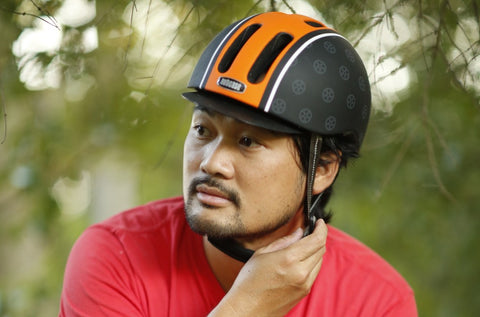A five step guide to fitting your bike helmet

If you ride a bicycle then you need to wear a helmet. That's the law, contentious as it may be for some. So, if you have to wear one then here is a simple five step guide to help you fit your bicycle helmet so it does the job it is meant to do i.e. protect your head from serious injury in the event of a fall.
1. Check or measure your head for size
A lot of bike shops will have a tape measure to measure your head to help you choose the correct size. If not, or the bicycle helmet you like doesn't come in different sizes, try it on for size. It is too big if it falls into your eyes when you nod your head. It is too small if it doesn't go on (ha ha - I couldn't resist) or you will feel like it is squeezing your head. This is the worst scenario as you will get a nasty headache very quickly.
2. Adjust the helmet pads and/or the rear dial
Your bicycle helmet fits correctly when the pads hold it firmly but comfortably in place. Most brands of helmets provide extra padding with different thicknesses for this purpose. Try different combinations of padding to get the most comfortable fit. Bicycle helmets that don't have padding often have a dial at the back that you can rotate to make the helmet fit more loosely or snugly.
3. Wear your helmet low at the front
Helmets that 'ride high' and are tilted back do not offer much protection to your forehead. Wear your helmet low in front to both protect your forehead and keep a bit of sun off while you are riding.
4. Adjust your straps so you have the 'ear triangle'
The front and rear straps should join at a point slightly below and in front of your ears. (This is the 'ear triangle'). Most helmets come with a sliding buckle that joins the two straps and this can be slid up or down to position it correctly.
5. Adjust your chin strap
You should always wear your helmet with the chin strap fastened under your jawline, not on the chin where it could come off easily in an accident. if you can slide a finger between your strap and throat then that is usually about the right tightness. If you have a a length of strapping left over then use the bands to fasten them out of the way so they don't flap while riding.
The best fit is when the skin on your forehead moves a bit when you grab the helmet while wearing it and twist it from side to side. Keep adjusting straps and padding until you get this nice snug fit.
You will probably make mini adjustments the next few times that you wear it as well but this is a good guide to get it 90-95% right.
Remember, if you have a crash or drop your helmet then you should get a new helmet. The shell and linings are designed to absorb the impact and are often damaged in such an incident.
All of our helmets conform with Australian standards for bicycle helmets and have straps and padding that allow you to fit them properly and comfortably. Drop in at any time if you would like us to help you with a new one.




